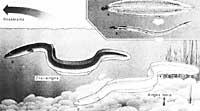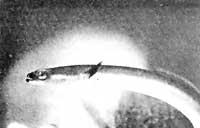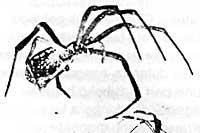Trying to unravel the mystery of Aingi...
1987/06/01 Eguskitza, Joxe Iturria: Elhuyar aldizkaria

Of this interesting animal, source of numerous legends, which has been and is source of income among the new Basque cooks. Where is it born?. Being eel, where do I put?. Why do we never find eel eggs?...1886. The life of this unique fish began to be known a little in the year 2000.
However, and as demand increases as food, fishing techniques improve, the catch of eel decreases. In fact, the eels that have spread all over the world have been naturally reproduced in the sea. To date, it has not been seen how this reproduction is carried out and it has not been possible to achieve successfully in the laboratories. The reason for this lies in the special biological cycle of eels.
The cycle is divided into two stages: from a long period of growth in the continental sweet waters (in which the eels do not mature sexually) and the natural reproduction that takes place in the sea (that is, in some unknown points of the sea of the sargazos, whether they are European or American eels). Therefore, research of the eel reproductive mechanism has a double interest: the economic and biological interest of the physiological reproduction of these curious fish.
In fact, mysteries about the reproduction of the eels (reproduction, production points, reproductive functions, etc. ). ), human concerns since ancient times. Aristotle, in his book Animal History and his treatise on animal creation, was the first to launch the theme of the creation of these fish. No seeds or eggs were found in these fish. For Plinus, the eels come from the skin balloons that come off rubbing against the rocks.

XVII. In the eighteenth century Leuwenhoek, mixed with parasite worms and intestinal angulas, defended the idea of the pondering vitalian eel. Linneo and Laceped would continue to defend this idea. XVII. In the nineteenth century, the Italian naturalist Francesco Redi, seeing that the mouth of the silver eels and the angles move along the river, said that the eels were reproduced at sea, drawing near.
Finally, the XIX. The discovery of the larval phase of the eel was made in the nineteenth century and twice. In 1856 J. The German Kamp discovered a new fish from the Mediterranean, Leptocephales brevirostris, and 40 years later, R. Grassi and S. The Italian Calendruccio showed that it was the larva of the eel. On the other hand, at the beginning of this century the cycle of the eel, J, was largely clarified. Thanks to the Danish Scmidt. It was dedicated to systematically searching for eel larvae and discovered the breeding area of the European and American eel in the Sargazos Sea, opposite the Mexican Gulf. In it were found the youngest larvae called preleptozefalo.
Today we know what is the cycle of the European eel or the European eel: From the sea of the Sargazos, the larvae called leptocéfalos, driven by the currents of the Gulf and after a trip of approximately three years, will arrive to the European coast. Upon reaching the continental slope, it will become an angle so appreciated among us. The angles penetrate the rivers at night. In these waters they will become eels. Between 10 and 20 years, eels called eels lead a quiet life.
During this period insects, molluscs, small fish and even smaller eels grow continuously. After this phase, they undergo new changes. The color change of the skin is the most prominent of all, and hence the name change, which is known as "silver eel". Once reached this level of maturity, it heads towards the sea of the Sargazos to make a journey without return. The downstream journey takes place in large groups, without taking into account the obstacles you will encounter.

Its objective is to reach the distant sea that is between the Antilles and Bermuda. On the way they will get the necessary sexual maturity and once there, about 1.000 meters deep, each female lays 10 million eggs. These are broken after fertilization by forming larvae.
When they reach sexual maturity, the eels darken their backs, increase their eyes and stop feeding, preparing for migration to the bottom. Eel meat is white, fine and somewhat sweet, with great appreciation in some places. But not in Euskal Herria, here is the angle.

Gai honi buruzko eduki gehiago
Elhuyarrek garatutako teknologia





